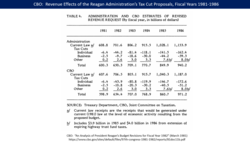Reaganomics

Reaganomics is a portmanteau word of Reagan and economics created by Paul Harvey.[1] It refers to the economic policies created by U.S. President Ronald Reagan during the 1980s and still widely practiced.
These policies are commonly used with supply-side economics, referred to as trickle-down economics by political enemies and free market economics by political advocates.
The four main ideas of Reaganomics were to reduce the growth of government spending, reduce the federal income tax and capital gains tax, reduce government regulation, and tighten the money supply in order to reduce inflation.[2]
Reaganomics Media
President Ronald Reagan signs the Economic Recovery Tax Act of 1981 at his California ranch.
Monthly unemployment, inflation, and interest rates from January 1981 to January 1989, according to the Bureau of Labor Statistics and Federal Reserve Economic Data
References
- ↑ Holley, Joe (March 1, 2009). Broadcaster Delivered 'The Rest of the Story'. https://www.washingtonpost.com/wp-dyn/content/article/2009/02/28/AR2009022802096_2.html. Retrieved March 1, 2009.
- ↑ "Reaganomics, by William A. Niskanen: The Concise Encyclopedia of Economics | Library of Economics and Liberty". www.econlib.org. Retrieved 2022-04-08.








